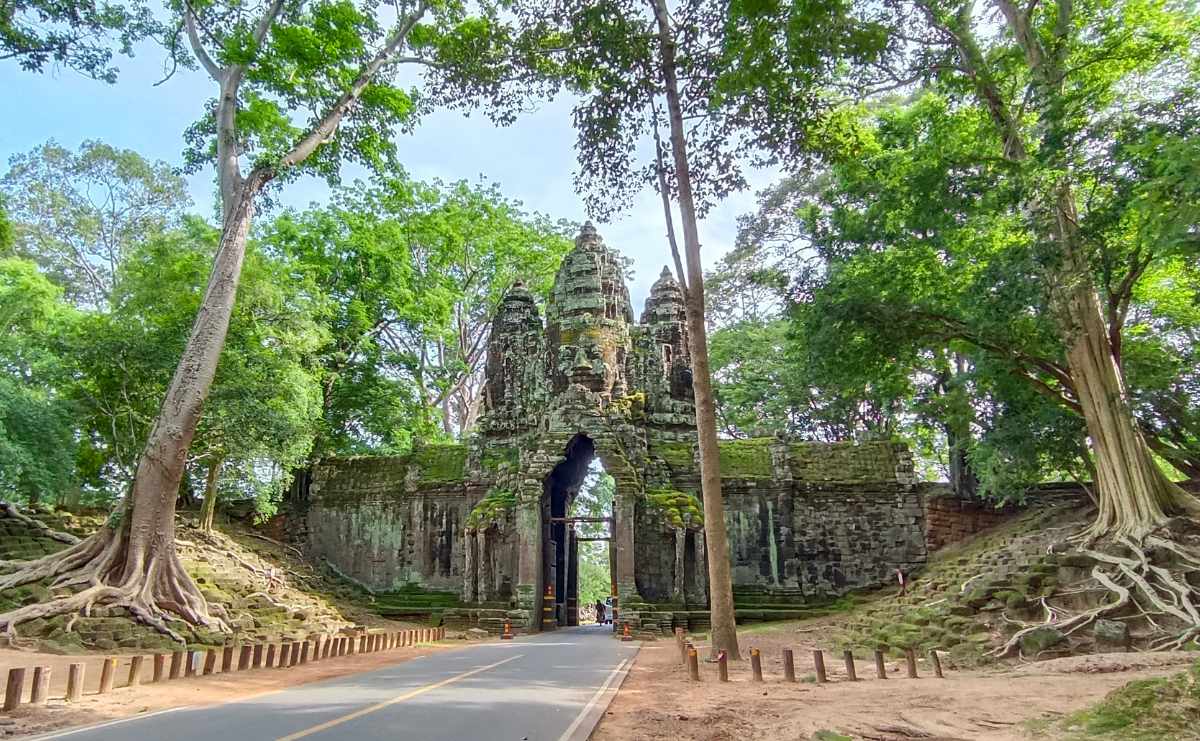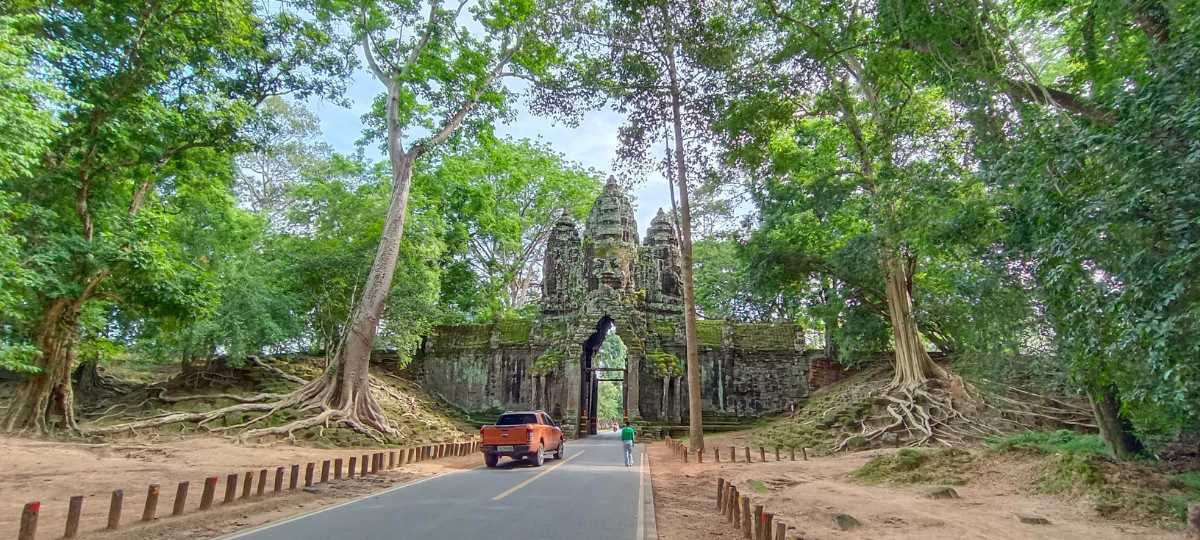The North Gate Of Angkor Thom
Planning a trip to Siem Reap and unsure which temples to prioritize? The North Gate of Angkor Thom, also known as Thvear Ta Nok, offers an unparalleled journey into history and scenic splendor.
This blog post unravels the exquisite architectural grandeur of this iconic monument and takes you on a virtual tour through its ancient corridors. Don’t miss out on this opportunity to peek into Cambodia’s rich cultural heritage!
Key Takeaways
- The North Gate of Angkor Thom, also known as Thvear Ta Nok, is one of the five grand entrances into the ancient city and holds immense historical and cultural significance.
- The architectural features of the North Gate are not only impressive but also rich in symbolism, showcasing the superb craftsmanship of the Khmer Empire.
- Exploring the North Gate offers a glimpse into Cambodia’s rich cultural heritage and invites visitors to immerse themselves in its scenic splendor.
- Preservation efforts and tourism initiatives have ensured that the North Gate’s cultural significance remains intact, allowing visitors to experience its ancient splendor.
The Importance and Significance of the North Gate of Angkor Thom
The North Gate of Angkor Thom holds immense importance and cultural significance as one of the five grand entrances into the ancient city, showcasing its historical background, architectural features, and symbolism.
Historical background and cultural significance
Steeped in rich cultural heritage, the North Gate of Angkor Thom holds an important place in Cambodia’s history. Known as Thvear Ta Nok, this intricate gate is an ode to the grandeur of the Khmer Empire, serving as a key entry point for King Suryavarman II and his court.
Situated two miles north of Angkor Wat, covering nearly four square miles, this ancient city encapsulates centuries-old traditions and beliefs through its majestic architecture. Distinct from other gates because of its royal patronage, it showcases some awe-striking carvings that capture various scenes from Hindu mythology representing nuances of Khmer culture.
The intertwining roots seeping into stones at northern causeway mirrors nature’s imposing resilience over human-made marvels while headless sculptures depict both time’s relentless wear and historical conflicts endured by Cambodian people.
Beyond its stunning visual appeal, stands the testament to the powerful past civilization shaping today’s Siem Reap region.
Architectural features and symbolism
The architectural features of the North Gate of Angkor Thom are not only impressive but also rich in symbolism. This grand entrance is adorned with intricate carvings and sculptures, showcasing the superb craftsmanship of the Khmer Empire.
The gate consists of a central tower flanked by two smaller towers, creating a beautifully balanced structure. The massive stone heads carved into the towers, known as “face-towers,” represent the bodhisattva Avalokiteshvara and symbolize protection and benevolence.
These iconic faces, with their serene expressions and elongated eyebrows, exude an aura of spirituality that immediately captures your attention upon arrival at the North Gate. As you explore further, you’ll notice other decorative elements such as nagas (serpent-like deities) and devatas (celestial beings), all meticulously carved into the sandstone walls to honor Hindu mythology and establish a connection between heaven and earth.
Exploring the Scenic Splendor of the North Gate
The North Gate of Angkor Thom enthralls visitors with its majestic entrance and grandeur, inviting them into a world of scenic splendor.
Majestic entrance and grandeur
As you approach the North Gate of Angkor Thom, prepare to be awestruck by its majestic entrance and grandeur. The towering stone structures adorned with intricate carvings and sculptures will leave you spellbound.
This iconic gateway is a testament to the architectural genius of the Khmer Empire, providing a glimpse into their rich history and cultural heritage. As you pass through this magnificent portal, you’ll feel like stepping into a different world, where time stands still and ancient wonders come to life.
1-day Angkor Wat GRAND LOOP Private tour with air-con minivan [with the famous Banteay Srei temple]
A Journey into History: Discovering Angkor Thom
Discovering Angkor Thom takes you on a captivating journey through history, as you explore the ancient layout and structure of this moated walled city.
The layout and structure of Angkor Thom
Angkor Thom, a magnificent ancient city located just two miles north of Angkor Wat, spans an impressive four square miles. The layout and structure of Angkor Thom are nothing short of awe-inspiring.
Designed in a perfect square shape, each side stretches approximately 3 kilometers, encompassing a vast area filled with breathtaking temples and monuments. This well-planned city is surrounded by a moat that adds to its grandeur and majesty.
Within the walls of Angkor Thom lies a complex network of roads and pathways that lead travelers on an unforgettable journey through history. Venture beyond the gates of this remarkable archaeological district, and you will discover hidden treasures waiting to be explored.
Highlighting the main temples and monuments within Angkor Thom
Within the ancient city of Angkor Thom, there are several magnificent temples and monuments that showcase the rich history and cultural heritage of Cambodia. Explore these must-visit sites during your visit to Siem Reap:
- Bayon Temple: One of the most iconic structures in Angkor Thom, Bayon Temple is known for its massive stone faces that adorn its towers. The temple is intricately decorated with bas-reliefs depicting scenes from everyday life, historical events, and mythological stories.
- Baphuon Temple: This pyramid-shaped temple is dedicated to the Hindu god Shiva and is considered one of the largest religious structures in Angkor Thom. Although it had fallen into disrepair, extensive restoration work has been done to bring back its former glory.
- Phimeanakas: Located within the Royal Palace complex, this three-tiered temple served as a royal chapel during the Khmer Empire. It offers breathtaking panoramic views of Angkor Thom from its highest level.
- Terrace of Elephants: This grand platform was used by King Jayavarman VII for public ceremonies and royal processions. The terrace is adorned with intricate carvings of elephants – a symbol of power and strength.
- Terrace of the Leper King: Situated just north of the Terrace of Elephants, this terrace features a statue believed to represent either Yama, the god of death or King Jayavarman VII himself.
- Preah Palilay: Nestled in a tranquil setting within Angkor Thom, this small temple offers visitors a peaceful escape from the bustling crowds. It features beautiful lintels and intricate carvings depicting scenes from Hindu mythology.
- Tep Pranam: This small Buddhist shrine is located along the eastern side of Angkor Thom’s Victory Square. It provides a serene setting for meditation or quiet reflection amidst lush greenery.
The North Gate Today: Preservation and Tourism
Preservation efforts and tourism initiatives have ensured the North Gate’s cultural significance remains intact, allowing visitors to immerse themselves in its ancient splendor.
Conservation efforts and restoration projects
Conservation efforts and restoration projects are integral to preserving the historical and cultural significance of the North Gate of Angkor Thom. As you explore this picturesque gateway into history, it’s important to understand the ongoing initiatives that ensure its longevity:
- Continuous maintenance: The Archaeological Survey of India (ASI) has been working closely with the Cambodian government to maintain and restore the structures within Angkor Thom, including the North Gate. Regular inspections and repair work are conducted to prevent further deterioration.
- Stone conservation: A significant aspect of restoration involves preserving the intricate stone carvings and sculptures at the North Gate. Skilled artisans use traditional techniques to clean, reinforce, and protect these ancient artworks from weathering and erosion.
- Documentation and research: Extensive documentation is carried out during restoration projects to capture valuable information about architectural details, carving styles, and historical context. This research helps experts gain insights into the construction methods employed during ancient times.
- Tourism revenue for conservation: Entrance fees paid by visitors contribute directly to restoration projects in Angkor Archaeological Park. Your visit to the North Gate supports ongoing conservation efforts aimed at maintaining this remarkable heritage site for future generations.
- Collaboration with international organizations: Cambodia has partnered with UNESCO and other international organizations to receive technical assistance in conservation practices. These collaborations ensure that best practices are followed, helping preserve not only the North Gate but also other sites within Angkor Thom.
- Education and training programs: Local communities are actively involved in preservation efforts through education and training programs offered by archaeological institutions. These initiatives help create awareness among locals about their rich cultural heritage while imparting skills necessary for sustainable conservation practices.
- Sustainable tourism practices: Efforts are underway to promote responsible tourism within Angkor Thom. Guidelines have been put in place to manage visitor flow while minimizing impact on delicate structures at the North Gate.
Visitor experiences and recommendations for exploring the North Gate
When exploring the North Gate of Angkor Thom, travelers to Siem Reap and Angkor can expect a truly mesmerizing experience. Here are some visitor experiences and recommendations for making the most of your time at this picturesque gateway into history:
- Take your time to fully absorb the grandeur of the North Gate. Admire the intricate carvings and sculptures that adorn its walls, showcasing the artistic mastery of the Khmer Empire.
- Capture stunning photographs at the northern causeway, where headless sculptures emerge from the earth intertwined with tree roots. This unique and captivating sight is a photographer’s dream.
- Engage in a guided tour to learn about the historical significance of the North Gate and its place within Angkor Thom. Expert guides can provide fascinating insights into the architectural features, cultural symbolism, and stories behind this ancient entrance.
- Venture beyond just visiting the North Gate itself. Explore the surrounding area, including other temples within Angkor Thom such as Bayon Temple with its enigmatic smiling faces or Banteay Srei Temple known for its exquisite pink sandstone carvings.
- Immerse yourself in nature by taking a stroll along the moat of Angkor Thom or enjoying a peaceful picnic amidst lush green surroundings.
The North Gate of Angkor Thom is a captivating gateway into the rich history and scenic beauty of this ancient city. From its majestic entrance to the intricate carvings that adorn its walls, it offers a picturesque journey into the past.
As you explore Angkor Thom and its temples, you’ll be transported to a bygone era, immersing yourself in the wonders of the Khmer Empire. Whether you’re an avid historian or simply seeking breathtaking landscapes, the North Gate of Angkor Thom is a must-visit destination that will leave you awe-inspired.
So pack your bags and embark on this unforgettable adventure through time and beauty.
The North Gate Of Angkor Thom – FAQs
What is the significance of the North Gate of Angkor Thom?
The North Gate of Angkor Thom holds great historical and cultural significance as it served as the main entrance to the ancient city. It is a remarkable architectural masterpiece that showcases the grandeur and power of the Khmer Empire.
Are there any other attractions near the North Gate of Angkor Thom?
Yes, there are several other notable attractions near the North Gate. Driving to reach the North Gate you will pass by Bayon Temple with its iconic smiling faces, Baphuon Temple known for its towering pyramid-like structure, Terrace of Elephants showcasing exquisite bas-reliefs, and other temples that are a bit farther from the main road, but still, just a walk away, such as Phimeanakas Temple and Prasat Preah Palilay.
PS: When you are in Angkor Thom, do not miss Baphuon Temple and the walk to Phimeanakas Temple and Prasat Preah Palilay! It is by far my favorite part! These sites add to your overall experience a unique point of view that most tours don’t offer.
Sources

